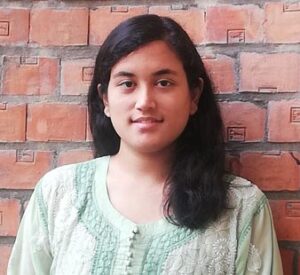R
 ecently, we had the opportunity to visit Meghalaya to explore the possibilities of conducting some joint activities with the Government of Meghalaya. One of the items on the agenda was a visit to a model anganwadi. The moment we heard this, different images, pictures and thoughts ran through our minds. We wondered why the anganwadi was called a model anganwadi. Sure enough, as we drove in, it was like entering a fairy land. The driveway was potted with plants and the colourful anganwadi loomed in front of us. We were sure that this would attract any child entering the premises — the colours, happiness and the positive environment were a pleasant sight.
ecently, we had the opportunity to visit Meghalaya to explore the possibilities of conducting some joint activities with the Government of Meghalaya. One of the items on the agenda was a visit to a model anganwadi. The moment we heard this, different images, pictures and thoughts ran through our minds. We wondered why the anganwadi was called a model anganwadi. Sure enough, as we drove in, it was like entering a fairy land. The driveway was potted with plants and the colourful anganwadi loomed in front of us. We were sure that this would attract any child entering the premises — the colours, happiness and the positive environment were a pleasant sight.
The anganwadi is housed in Mawadiangdiang and is called ‘My Anganwadi: A model (Mini) Anganwadi Centre’. It was inaugurated in 2020. The anganwadi fulfilled the criteria of being a “model” for several reasons:
- Cooperation across departments and schemes: One of the major reasons why this anganwadi became a reality is because of the cooperation between different government departments and the local community. The local Block Development Officer, Monica Kshir, saw that breaking past the silos in which most government departments work would help in realising a common vision. She worked directly with the village headman to bring together the different departments’ strength for the creation of the anganwadi.
Many of the local village leaders first became involved with the project due to their prior involvement with the Mahatma Gandhi National Rural Employment Guarantee Scheme (MGNREGS). The local MGNREGS government officials. along with the local village committee, took the lead in submitting the proposal for the development and construction of the anganwadi and the project was included in the MGNREGS programme for the year. The BDO and village headman then leveraged the resources that the village was allotted through other programmes and schemes and ensured that they were utilised at the anganwadi centre. In addition, various other departments provided support for the project through their prior experience, such as the Social Welfare Department which is responsible for the nutrition of the children who attend the anganwadi and Swachh Bharat Mission-Gramin that assisted in providing WASH facilities and the compost pit at the anganwadi. The BDO also made use of the generosity of departments such as the CRPF, which are not traditionally involved in this type of project and submitted proposals to the CRPF Civic Action Programme to mobilise additional resources for the anganwadi. - Cooperation from the village locals: The very fact that the main headman of three sub-localities, Tishalding Kharkongor, Rangbah Shnong, Basil Nongbri, Rangbah Dong (sub-headman of the locality) and William Nongthlaw, Rangbah Dong, whom we met conveyed that their personal struggles of not being educated was the main motivator to support and ensure that establishing this anganwadi should be a success.
- Spearheaded by Government officials: Monica Kshir, BDO, Mawpat, did everything in her capacity since she also believed in making this dream a reality. She not only gathered the support of the local communities but also ensured that the anganwadi centre is safe for children, bright, cheerful and a place any child would love to go. The bright and colourful paintings on the walls was an example of this. The small patch of vegetable garden was an excellent feature where children were taught to nurture plants and respect the environment. The playing materials also ensured that a child could experience an all-round and holistic development and experience. Kshir’s unwavering focus on the shared vision of the anganwadi was the key in its creation. She saw early on that leveraging skills and resources across departments was vital to its success. As she says, “Unless we come together… with the locality, [and] the departments and let them be one team so that we can better implement the schemes for a more visible effect.” She hopes that based on this model anganwadi, this concept of working together as a team can be repeated in many other areas.
As the saying goes, “Where there is a will there is a way” and this is completely applicable to this entire project. Our key takeaways include:
- Believe in what you want to do
- Community mobilisation is very important, since it brings in ownership and sustainability
- Build your dreams using local talents and make use of available elements
- Think small and act big.
(Public Affairs Foundation was established in 2003 as a not-for-profit company. It is primarily a knowledge-based organisation that is dedicated to improving the quality of public governance by providing advisory services)





